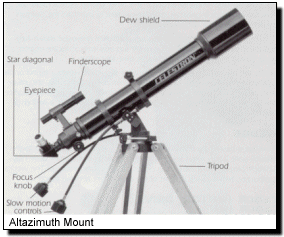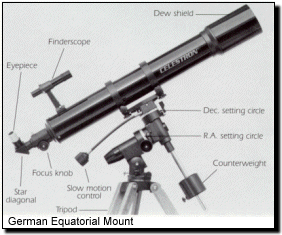|
MECHANICAL TERMS AND
CHARACTERISTICS OF TELESCOPES
TELESCOPE MOUNTS
(STABILITY)
To a large extent, a telescope is only as good as its
tripod and mounting. A telescope magnifies everything, including vibration.
That's why many telescopes with decent optics are rendered useless when supplied
on a cheaply made mount. The mount's adjustments should be smooth, yet precise,
as you'll be using them to track the slow and steady apparent movement of the
stars. Smooth and precise movements (and a motor drive) are an absolute
requirement for astrophotography.
 A telescope mount has two functions- (1) provide a system
for smooth controlled movement to point and guide the instrument, and (2)
support the telescope firmly so that you can view and photograph objects without
having the image disturbed by movement. A telescope mount has two functions- (1) provide a system
for smooth controlled movement to point and guide the instrument, and (2)
support the telescope firmly so that you can view and photograph objects without
having the image disturbed by movement.
There are two major types of mounts for astronomical
telescopes:
(1) Altazimuth -- the simplest type of mount with two motions, altitude (up and
down/vertical) and azimuth (side-to-side/horizontal). Good altazimuth mounts
will have slow-motion knobs to make precise adjustments, which aid in keeping
tracking motion smooth. These type mounts are good for terrestrial observing and
for scanning the sky at lower power but are not for deep sky photography.
Certain altazimuth mounts are now computer driven and allow a telescope to track
the sky accurately enough for visual use but not for long exposure
photography.
(2) Equatorial -- superior to non-computerized altazimuth mounts for astronomical
observing over long periods of time and absolutely necessary for
astrophotography. As the earth rotates around its axis, the stationary stars
appear to move across the sky. If you are observing them using an altazimuth
mount, they will quickly float out of view in both axes. A telescope on an
equatorial mount can be aimed at a celestial object and easily guided either by
manual slow-motion controls or by an electric clock drive to follow the object
easily across the sky and keep it in the view of the telescope. The equatorial
mount is rotated on one axis (polar/right ascension) adjusted to your latitude
and that axis is aligned to make it parallel to the Earth's axis, so that if
that axis is turned at the same rate of speed as the Earth, but in the opposite
direction, objects will appear to sit still when viewed through the
telescope.
There are two basic types of equatorial
mounts:
(a) German Mount -- both Newtonian and refractor telescopes normally use this
type mount. A large counterweight extending on the opposite side of the optical
tube is its distinguishing feature. The counterweight is needed to balance the
weight of the optical tube.
 (b) Fork
Mount -- most catadioptric
and other shorter optical tubes use this style mount which is generally more
convenient to use than the German mount, especially for astrophotography. A more
recent state-of-the-art computer controlled telescope allows fully automatic
operation making it extremely fun and easy to locate objects while saving the
observer considerable time and effort. (b) Fork
Mount -- most catadioptric
and other shorter optical tubes use this style mount which is generally more
convenient to use than the German mount, especially for astrophotography. A more
recent state-of-the-art computer controlled telescope allows fully automatic
operation making it extremely fun and easy to locate objects while saving the
observer considerable time and effort.
Unless the telescope is a tabletop model, it should
be set on a tripod or pier-type platform. These must be rigid and minimize
vibration. They should be portable and lightweight as well as easy to handle and
set up. Appearance can be deceiving, as bulk and weight are not as important as
a well engineered tripod or pier.

WEDGE
A wedge is usually used with a fork mount to tilt
your telescope up to the celestial pole, at an angle equal to your latitude so
that a clock drive may function properly and the setting circles give accurate
readings. The wedge is mounted between the bottom of the fork mount and the
tripod.

CLOCK
(MOTOR) DRIVE
An electrical system of motors and gears utilized
with an equatorial mount. It compensates for the Earth's rotation during
astronomical usage keeping celestial objects centered in the field of
view.
A clock drive is essential to do astrophotography.
The electrical system can be AC or DC depending on the type of system used. The
gearing system is usually a spur gear or a worm gear type, both of which can be
good if manufactured properly.

SETTING
CIRCLES
Dials for right ascension and declination that allow
you to locate celestial objects easily from their coordinates as listed in star
charts. For setting circles to work effectively, the telescope must be
equatorially mounted and polar aligned.
Digital setting circles allow you to computerize your
telescope. They have thousands of objects in their databases and allow you to
see numerous objects in an evening.

FINDERSCOPE
A small auxiliary telescope with crosshairs attached
to the main telescope. It is of low power with a wide field of view and assists
you in pointing to find objects to observe through the main telescope. Most
finderscopes give an upside down and left/right reversed image.

STAR
DIAGONAL
With some telescope designs the viewing position of
your eye is in an awkward position when observing overhead. A star diagonal (a
prism or mirror set at a 90 degree angle to the telescope tube) is designed to
make viewing of the sky more convenient and comfortable and swivels right and
left as required. Newtonian-type telescopes do not need a star diagonal since
the eyepiece is normally in a comfortable viewing position already.

EYEPIECE
(OCULAR)
An eyepiece is simply a precision magnifier. The
eyepiece used with a telescope magnifies the image that is formed by the main
optical system. There are many different kinds of eyepiece designs for various
applications. The design and quality of the eyepiece can drastically affect the
overall performance of the telescope system. Common barrel diameters are .96",
1¼" and 2".

ACCESSORIES
Barlow Lenses, Eyepiece Filters, Motor Drives,
T-Adapters, Dec. Motors, Guiders, LPR Filters, Tele-Extenders, Solar Filters are
the names of a few accessories in an enormous offering of accessories for
telescopes. As your interests expand, accessories are available to help you
achieve maximum satisfaction.

|


